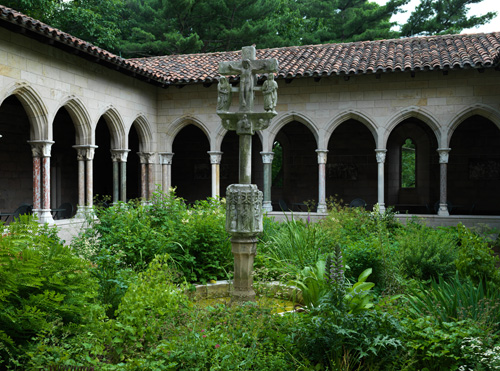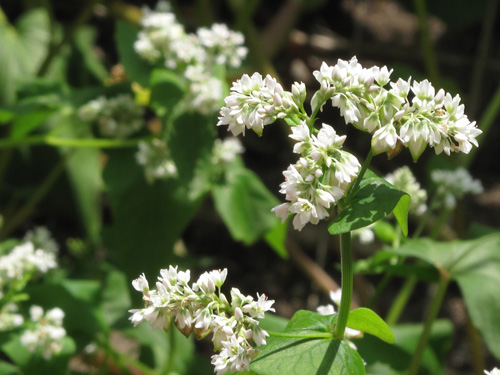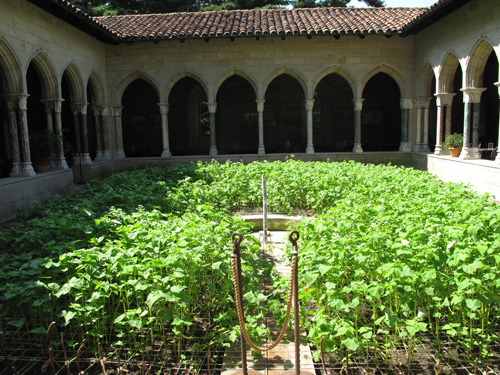A view of Trie garden before the renovation began.
Many years ago, due to a failed drainage system, Trie garden began to show signs of decline.??Medieval species struggled to grow within this tucked-away space, which remained untamed until the issue could be addressed. Although when I first encountered Trie it was in visible need of repair, I saw it as a magical, secret garden, whose wild arrangement only added to its allure. Like Bonnefont and Cuxa, Trie is intimate and beautiful, but of the three it is more often stumbled upon rather than sought out. Perhaps what drew me to Trie was its enormous hidden potential.
This past spring we began to reclaim Trie, part of an exciting three-year renovation plan.??In March we dug up all the plants, had the drainage system fixed and the bricks (all of them!) leveled, installed garden edging, and dumped, turned in, and leveled many yards of soil.??For this season, we decided to sow a “green manure,” let the soil settle over winter, and begin our first round of planting in the spring of 2013.
Buckwheat (Fagopyrum esculentum) was the green manure of choice. A member of the Polygonaceae family, which also includes rhubarb, dock, and sorrel, buckwheat grows very quickly (maturing in thirty to forty days) and can tolerate unfavorable conditions.??It is not only a medieval species, but it’s also specifically grown in gardens to add organic matter to the soil and increase its nutrient content.??It is recommended to chop up and turn in the plant just after it begins to flower.
Our first attempt to sow the seed left us with a patchy crop that was less than ideal. It looked unmanaged, and more like a weed than an intentional cover crop. It was hard to decipher whether the seeding itself was uneven, there was a problem with sunlight (the north side of the garden receives far more light than the south), our pesky resident sparrows were snacking on the seed, or a combination of all three. My coworker and co-conspirator, Esm?? Webb, and I began brainstorming alternative ways of sowing the seed rather than throwing it on and raking it in (similar to seeding grass), which had produced unsatisfactory results. With our garden forces combined, we came up with a new experiment.
The idea was simple: string a grid across both the length (north to south) and width (east to west) of the garden to create a web of thousands of squares. Each square would be our mark to hand sow individual seeds. Hand sowing would put the seed further into soil, making it a bit more difficult for the birds, and the mass webbing would create a barrier that would discourage the birds (or some of them!) from eating the seed. The precision of this seeding, paired with the “barrier” created by the twine would create an evenly spaced and protected crop of buckwheat, and allow us to determine whether spacing, light, and/or the birds were at all part of the original problem.
The materials needed were minimal: conventional twine, “stakes,” seeds, and scissors. We would tie each piece of twine to a stake, run it across the garden to its corresponding stake, and tie it off.??(The stakes were actually adapted from the shoots we had pruned and saved this past winter from our pollarded crab apple trees in Cuxa Cloister. For more on pollarding, see “Woodswoman, Pollard That Tree,” February 25, 2011.) The attached twine would sit a few inches above the soil line, and the stakes would be spaced a few inches apart, around the entire perimeter of the garden.
We charged into Trie garden with bundles of twine, buckets of stakes, packets of buckwheat, and a lot of curiosity.??With the help of our garden volunteers and wonderful summer intern Maggie Fitzgerald, who wrote a post two weeks ago, we pushed all the stakes into the ground, tied and ran the twine, and systematically began to sow each tiny seed, one by one, in rows.??Many, many hours???and a few days???later, we had finished sowing, and what a sight it was.??Not only had we completed our goal, but we had also created an installation that intrigued visitors, and, I hope, made it clear that the coming crop of buckwheat was intentional.
The author sowing buckwheat in Trie garden.
We observed and misted the garden daily.??The resident sparrows were still in the garden, and I began to worry that all of our hard work in the sun would be pecked away. But within a few days’ time, the buckwheat began to germinate evenly. After a week, the buckwheat was already a few inches tall, and a beautiful, even crop of green manure was on its way.
The crop became a playground for the resident sparrows of The Cloisters.
The ever present sparrows continued to be a nuisance, chomping on the emerging leaves and ripping the whole plant out of the ground; we could only wait patiently to see what would happen. After a few weeks of careful watering and observation, Trie garden was still an even, lush green, and continuing to grow.??Within just over a month’s time, our precious buckwheat was fully mature and had begun to flower.
The small buckwheat flowers were a popular destination for bees, particularly in the morning.
The honeybees emerged and found their way to buckwheat’s bountiful supply of nectar (mostly in the morning hours), and the sparrows seemed to enjoy the flowers equally as well as swinging and playing on the tall stalks.??A whole life and energy emanated out of our newly reclaimed garden, and it was invigorating.
The buckwheat grows!
Our experiment was a success. We now knew that the differing light conditions on the north and south side of the garden were not a contributing factor to the original problem, but that spacing and the lovely birds were. We were able to grow our green manure successfully to improve and care for the soil in preparation for next spring’s planting. Just yesterday we pulled out the buckwheat, which will be chopped up and worked into the soil on the outside grounds. A second round of buckwheat will be hand sowed once again within our webbed grid and this green manure will be added to Trie garden.
???Carly Still, Assistant Horticulturist
Tags: buckwheat, Fagopyrum esculentum, Polygonaceae, sowing, Trie Garden






September 16, 2012 at 8:09 pm
Lovely! I enjoyed the journey.
September 22, 2012 at 6:04 pm
What a lovely garden and fun project. There is just something so magical about a cloister garden. I will be watching to see it unfold.
But I am curious about why you pulled out the buckwheat and took it away instead of cutting and leaving it in place as a mulch. Are you replanting right away to get in another crop before winter?